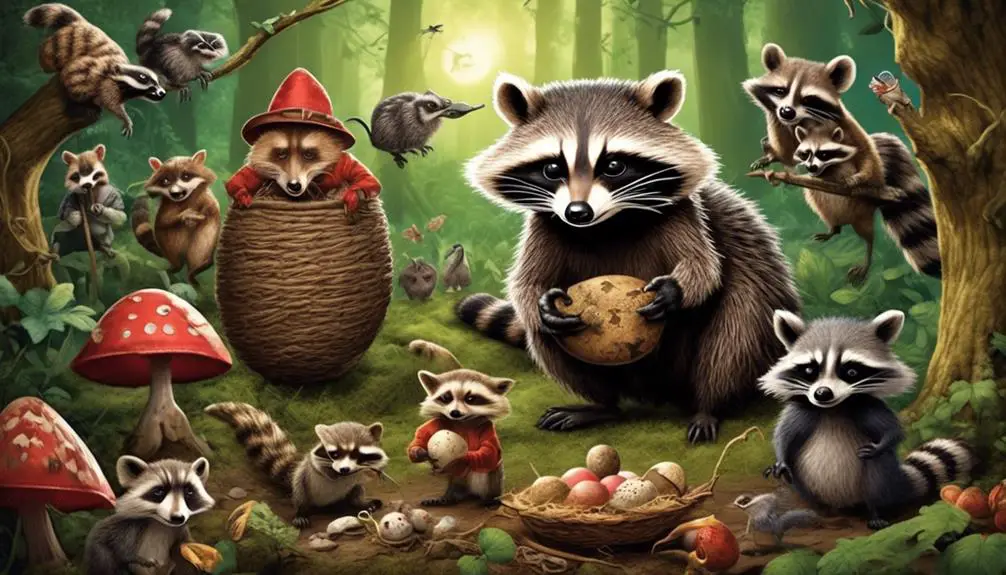Welcome to the intriguing world of egg-eating villains! Like cunning thieves in the night, these creatures prowl the land, searching for their precious loot. They are the sneaky culprits who disrupt the peaceful existence of bird nests, snatching away the delicate treasures within.
But who are these nefarious characters? How do they carry out their devious acts? And what impact do they have on the fragile balance of ecosystems?
Brace yourself as we unravel the secrets behind the villainous animals that prey on bird eggs, and prepare to be captivated by their cunning ways and the consequences they leave in their wake.
Raccoons, Opossums, and Badgers
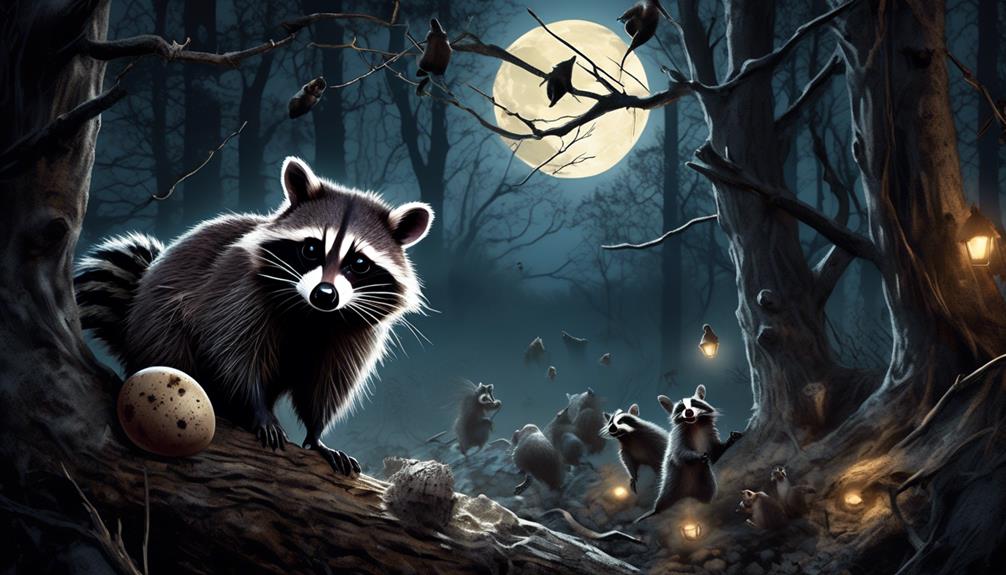
Raccoons, opossums, and badgers, as omnivorous animals, exhibit a remarkable ability to raid bird nests and cunningly steal the precious eggs contained within. These cunning creatures employ various strategies to access the nests and indulge in their delectable contents.
Raccoons, with their dexterous paws, skillfully manipulate eggs. Their nimble fingers allow them to grasp and carry eggs to a safe location for consumption.
Opossums, on the other hand, utilize their climbing abilities to reach high nests. Scaling trees with agility, they snatch eggs from unsuspecting birds.
Badgers, known for their strong teeth and sharp claws, crack open eggs with ease, relishing the nutrient-rich contents.
These opportunistic animals are driven by their insatiable hunger and will consume any available food source. Bird eggs, with their high protein and fat content, provide a valuable and nourishing meal for these creatures. Their ability to raid bird nests contributes to their survival and reproductive success.
In the intricate web of nature, the theft of bird eggs by raccoons, opossums, and badgers serves as a reminder of the fierce competition for resources in the animal kingdom. Through their cunning and adaptability, these creatures secure their place as skilled predators, adept at exploiting the vulnerabilities of unsuspecting birds.
Crows and Hawks
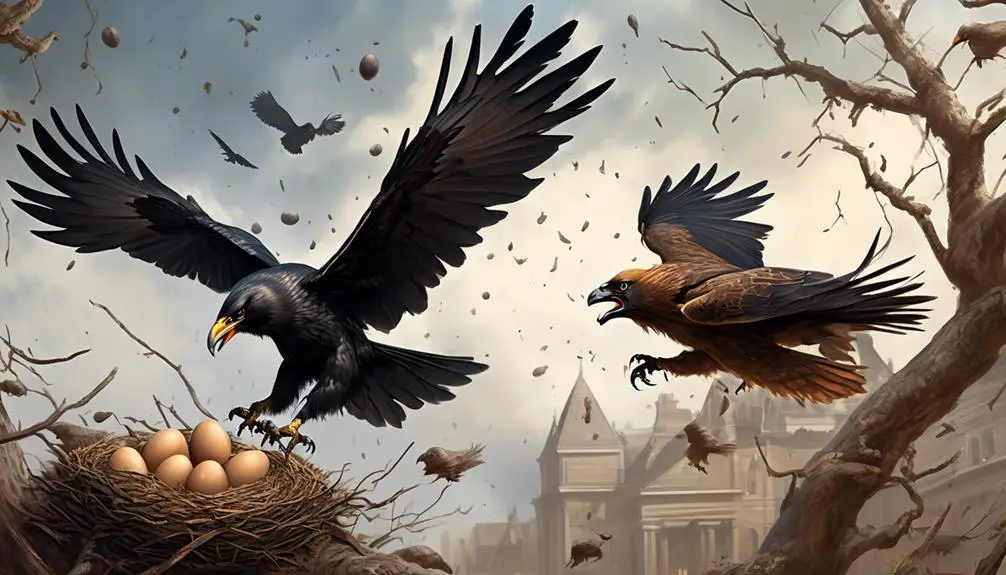
Crows and hawks, with their keen intelligence and opportunistic scavenging behavior, are skilled predators that can locate and raid bird nests for eggs. These birds possess unique adaptations that aid in their egg-stealing capabilities.
Crows, for example, have strong beaks that allow them to crack open eggs and access the nutritious contents within. Hawks, on the other hand, rely on their sharp talons to snatch eggs from nests and even prey on baby hatchlings. Their hunting techniques are precise and efficient, making them formidable egg predators.
Both crows and hawks play an important role in controlling bird populations. By preying on eggs, they help regulate the number of birds in an ecosystem, ensuring a balance between predator and prey. Their presence also influences the behavior of nesting birds, as they must be cautious and protective of their eggs to avoid falling victim to these cunning predators.
Observing crows and hawks in their natural habitat reveals their strategic approach to egg hunting. They often perch near bird nests, patiently waiting for the perfect opportunity to strike. Once a nest is unattended or momentarily vulnerable, they swiftly swoop in to claim their prize. Their actions demonstrate their adaptability and resourcefulness, traits that have allowed them to thrive in various environments.
Blue Jays and Lizards
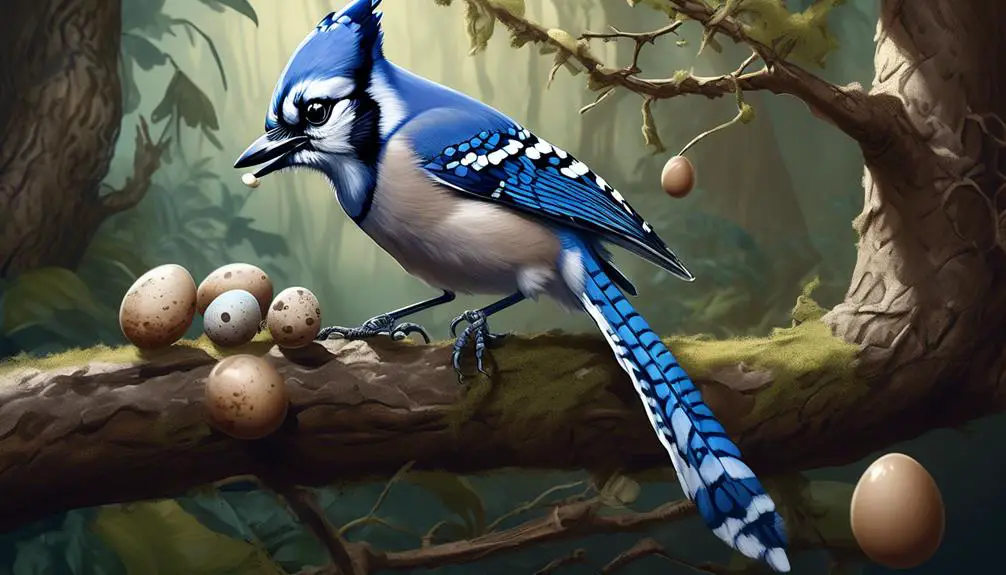
Blue jays and certain lizard species have been observed as notorious egg thieves, displaying remarkable agility and cunning in their pursuit of smaller bird eggs. Blue jays, known for their vibrant blue feathers and raucous calls, are skilled at locating and raiding bird nests. They consume the entire egg, including the shells, providing them with essential nutrients. Lizards, on the other hand, use their long tongues and agile climbing abilities to capture eggs. They play a crucial role in maintaining the balance of the ecosystem.
To provide a visual representation of the topic, here is a table showcasing the characteristics and behaviors of blue jays and lizards as egg thieves:
| Blue Jays | Lizards |
|---|---|
| Remarkable agility and cunning in stealing smaller bird eggs | Long tongues and agile climbing abilities |
| Consumes entire egg, including shells | Captures eggs for consumption |
| Vibrant blue feathers and raucous calls | Plays a role in maintaining ecosystem balance |
Blue jays and lizards are fascinating creatures that have adapted their skills to become successful egg thieves. Their ability to locate and consume bird eggs highlights the complexity of nature’s food chain.
Squirrels and Groundhogs
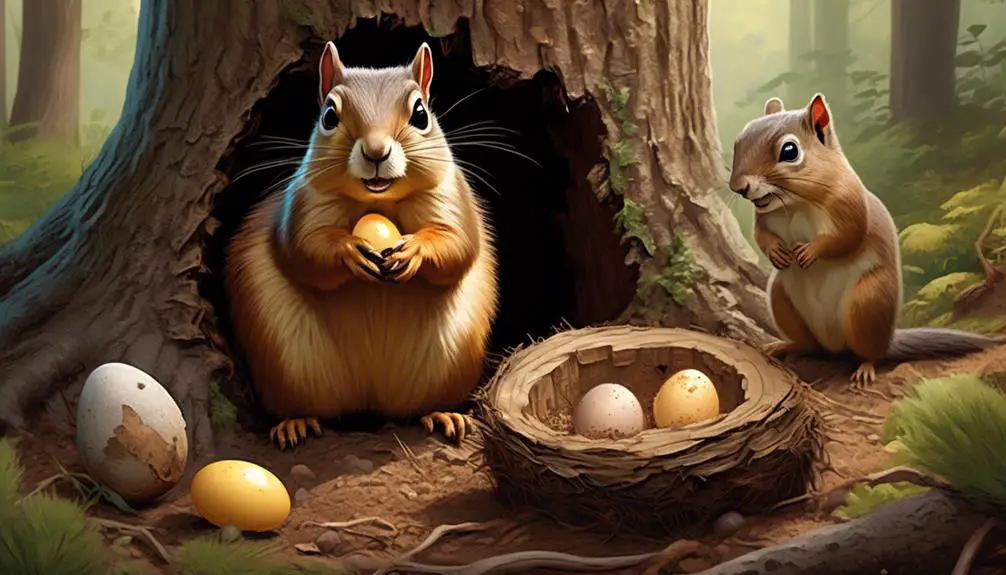
You observe that squirrels and groundhogs are notorious for raiding bird nests to steal eggs. These animals have the ability to access nests in trees and use their sharp teeth to crack open the eggs.
Squirrels are agile climbers, while groundhogs can dig burrows near nests to gain access.
Their opportunistic feeding behavior can have a significant impact on bird populations, as they consume eggs that would have otherwise hatched into young birds.
Nest Raiding Behavior
Squirrels and groundhogs exhibit nest raiding behavior, targeting bird nests to steal eggs and feed on them. They are agile climbers and opportunistic feeders, using their sharp teeth to crack open eggs and access nests. Groundhogs, in particular, can dig burrows near nests, making it easier for them to reach the eggs. To illustrate their nest raiding behavior, here is a table showcasing the characteristics and behaviors of squirrels and groundhogs:
| Squirrels | Groundhogs | |
|---|---|---|
| Habitat | Trees and forests | Grasslands and burrows |
| Diet | Nuts, seeds, fruits | Plants, vegetables, insects |
| Nesting habits | Build leaf nests or dreys | Dig burrows |
| Nest raiding behavior | Target bird nests in trees | Access nests through burrows |
| Method of stealing eggs | Use sharp teeth to crack eggs | Dig near nests to reach eggs |
These behaviors demonstrate their adaptability and resourcefulness in finding food sources, even at the expense of bird nests and eggs.
Methods of Access
Squirrels and groundhogs exhibit remarkable methods of accessing bird nests in their relentless pursuit of eggs to sustain their diet and survival.
Squirrels, with their nimble bodies and sharp teeth, are adept climbers and can effortlessly navigate the branches to reach nests located high up in trees. Their strong jaws allow them to crack open the eggs and consume the nutritious contents inside.
Groundhogs, on the other hand, utilize their impressive digging skills to create burrows near bird nests. These burrows provide them with convenient access to the eggs, which they eagerly devour.
Both squirrels and groundhogs are opportunistic feeders, always on the lookout for an easy meal, and their adaptability and resourcefulness make them formidable predators of bird eggs.
Impact on Bird Populations
In their relentless pursuit of eggs to sustain their diet and survival, squirrels and groundhogs have a significant impact on bird populations. Squirrels, with their sharp teeth, are adept at cracking open eggs, while groundhogs, with their ability to dig burrows near nests, can easily access and steal eggs.
These animals, known for their agility and opportunistic feeding habits, pose a threat to bird populations by reducing their reproductive success. The loss of eggs can lead to a decline in bird numbers, as it directly affects their ability to reproduce and maintain healthy populations.
Additionally, the constant presence of squirrels and groundhogs in bird habitats can cause stress and disturbance, further impacting the overall well-being of bird populations.
Understanding and managing the interactions between these animals is crucial for preserving bird populations and maintaining the balance of ecosystems.
Pigs
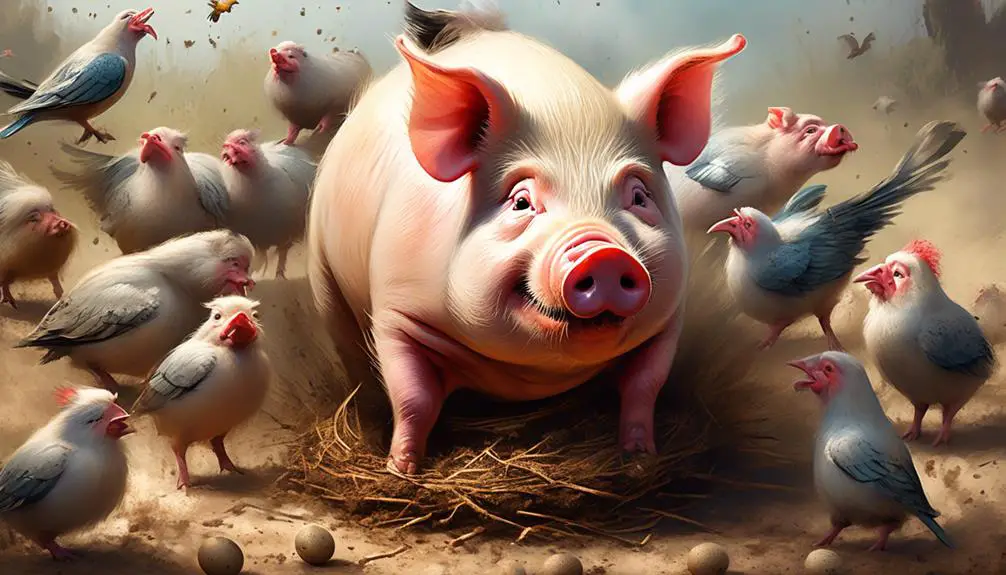
Pigs, being omnivorous animals with a preference for animal-based food, are notorious for raiding bird nests and consuming the contents of eggs. These opportunistic feeders have the ability to access nests, especially those on the ground, and indulge in the nutritious contents of the eggs. Pigs possess a keen sense of smell that enables them to detect the scent of eggs from a considerable distance. Once they locate a nest, they use their snouts to root around and expose the eggs. Their strong jaws and sharp teeth allow them to break open the eggs and consume the yolk and albumen inside. However, it is interesting to note that pigs reject the eggshells, as they do not provide any nutritional value.
To paint a clearer picture of the impact of pigs on bird populations, let’s examine a table of some notable bird species and their vulnerability to pig predation:
| Bird Species | Vulnerability to Pig Predation |
|---|---|
| Ground-nesting birds | Highly vulnerable |
| Shorebirds | Moderate vulnerability |
| Waterfowl | Low vulnerability |
It is essential to implement protective measures, such as fencing and deterrents, to prevent pig attacks on bird nests. By doing so, we can help safeguard the populations of vulnerable bird species from the voracious appetites of these omnivorous animals.
Snakes

Snakes are fascinating creatures that are notorious for their ability to prey on bird eggs. They’re skilled climbers, allowing them to reach nests high up in trees.
With their powerful jaws, snakes can swallow eggs whole, regurgitating the shells afterwards.
Snakes play a significant role in reducing bird populations by targeting both eggs and young nestlings.
Nest Predators
Nest predators, such as snakes, exhibit a remarkable ability to locate and raid bird nests, posing a significant threat to the survival of eggs and young nestlings.
Snakes, with their slender bodies and excellent climbing skills, can infiltrate even the most well-hidden nests. Their forked tongues help them detect the scent of eggs, guiding them straight to their prey.
Once they reach the nest, snakes use their powerful jaws to swallow eggs and hatchlings whole, regurgitating the indigestible eggshells. It’s a swift and efficient process. Snakes can consume multiple eggs in one feeding, decimating entire clutches.
The impact of their predation on bird populations is undeniable, making them one of the most notorious nest predators in the animal kingdom.
Egg Consumption
While raiding bird nests, certain predators exhibit a remarkable ability to consume bird eggs in a swift and efficient manner. Snakes, in particular, are notorious egg eaters in the wild. These stealthy reptiles are capable of attacking bird nests, including nests of larger birds like crows and eagles. With their ability to climb trees, snakes can effortlessly reach the eggs nestled in the branches.
Once the eggs are within reach, snakes use their muscular bodies to swallow the eggs whole, regurgitating the eggshells later. This method allows them to consume the eggs and any young nestlings in one gulp. Snakes play a significant role in controlling bird populations, as their voracious appetite for eggs helps keep the numbers in check.
Foxes
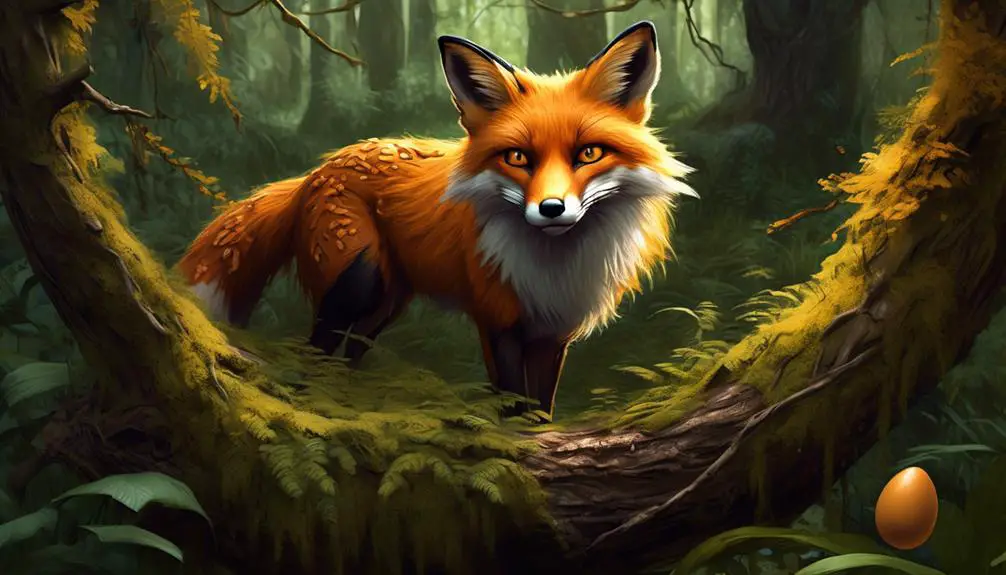
Foxes are agile and opportunistic predators that pose a threat to ground-dwelling birds and their nests, making them an important topic of discussion in the context of animals that eat bird eggs. These cunning creatures, belonging to the Canidae family, have adapted to various habitats, including forests, grasslands, and urban areas.
Foxes, such as the red fox (Vulpes vulpes), have sharp teeth and nimble paws, allowing them to raid nests with ease. They’re known to target ground-nesting birds like mallards, partridges, and pheasants. With their keen sense of smell and hearing, foxes locate nests, snatch eggs, and carry them away to consume elsewhere.
While foxes primarily rely on animal-based food, they’re opportunistic eaters and can survive on a plant-based diet if necessary. Their varied diet includes smaller mammals, insects, fruits, and even carrion. However, the eggs of ground-dwelling birds provide a valuable source of nutrition for these crafty predators.
To protect their nests from foxes and other egg-eating animals, ground-dwelling birds have evolved various strategies. They may camouflage their nests or build them in hidden locations. Additionally, some species employ distraction displays or mobbing behaviors to deter predators.
Crows, Lizards, and Groundhogs
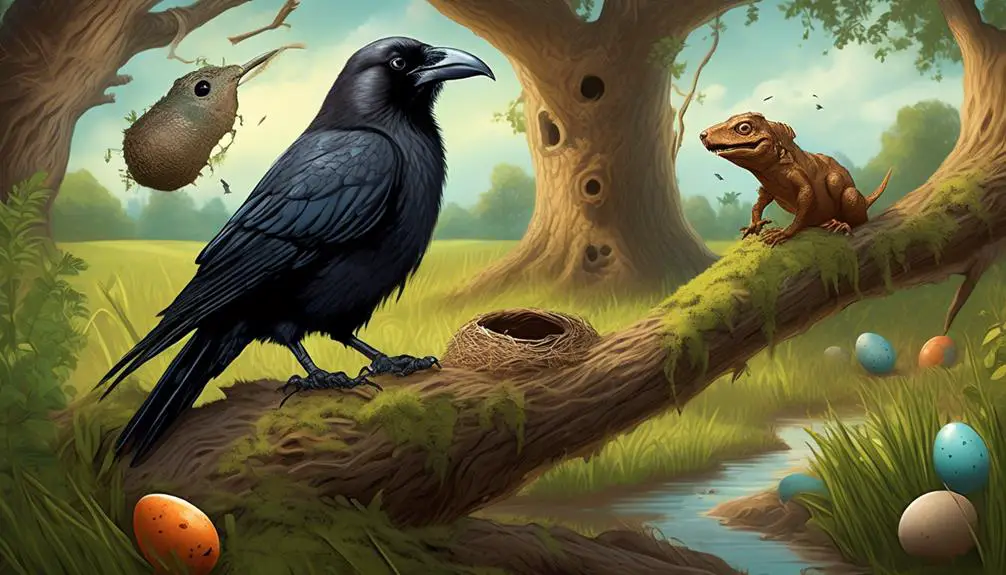
Crows, lizards, and groundhogs, being opportunistic feeders, have been observed to consume bird eggs as part of their varied diet. Crows, with their adaptable nature, are known for their intelligence and scavenging skills. They’ve a strong beak that allows them to crack open eggs and access the nutritious contents inside. Lizards, on the other hand, are agile climbers equipped with long tongues that enable them to capture eggs from smaller bird nests. These reptiles play a crucial role in maintaining ecosystem balance by controlling the population of certain bird species.
Groundhogs, also known as woodchucks, are opportunistic feeders that can raid bird nests to obtain eggs. They’re particularly adept at digging burrows near nests, providing them with easy access to the eggs. Groundhogs have sharp teeth that allow them to crack open the eggs and consume the nutrient-rich yolk. Similar to crows and lizards, they’re adaptable animals that can thrive in various environments.
The consumption of bird eggs by these animals serves as a reminder of the complex predator-prey relationships in nature. While birds have developed various strategies to protect their nests and offspring, the presence of opportunistic feeders like crows, lizards, and groundhogs adds an additional level of challenge to their survival. Understanding these dynamics is essential for studying the intricate web of interactions within ecosystems.
Raccoons, Opossums, Badgers, and Pigs
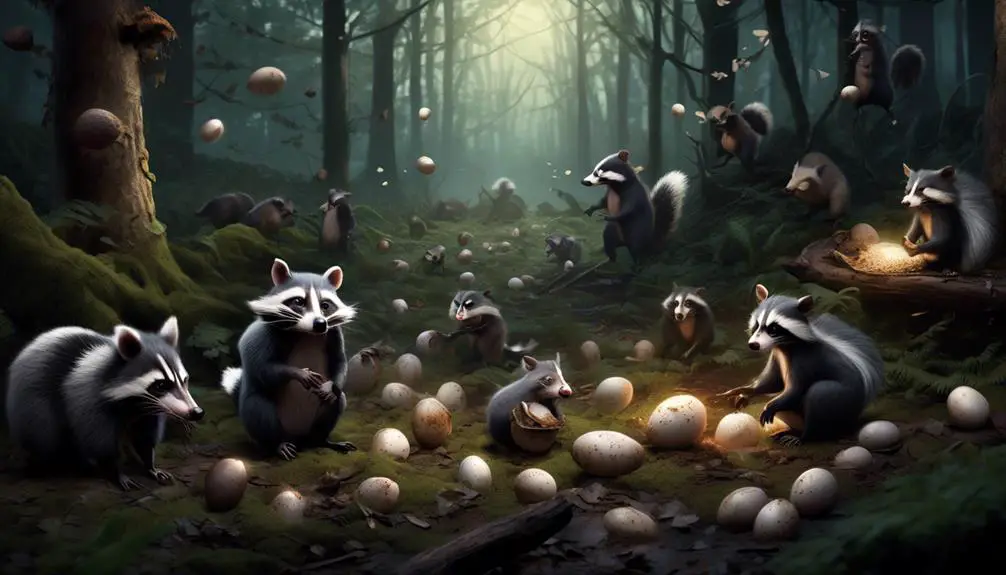
As we shift our focus to the subtopic of raccoons, opossums, badgers, and pigs, it becomes evident that these animals are also opportunistic feeders with a penchant for raiding bird nests and consuming their precious eggs. Raccoons, opossums, and badgers are known to be omnivorous creatures, meaning they’ve a varied diet that includes both plant-based and animal-based food. These animals possess the physical capabilities to access bird nests and steal eggs. Raccoons have dexterous paws that allow them to manipulate eggs, while opossums and badgers can climb trees to reach nests.
With their sharp teeth and claws, they’re able to break open the eggs and consume their contents. Pigs, another animal in this group, are capable of raiding bird nests, particularly those on the ground. Although they reject the eggshells, pigs consume the nutritious contents of the eggs, providing essential nutrients for their own diet.
These animals, with their opportunistic nature and ability to raid bird nests, are considered pests by poultry farmers and can cause significant damage to both nests and eggs.
Protective Measures
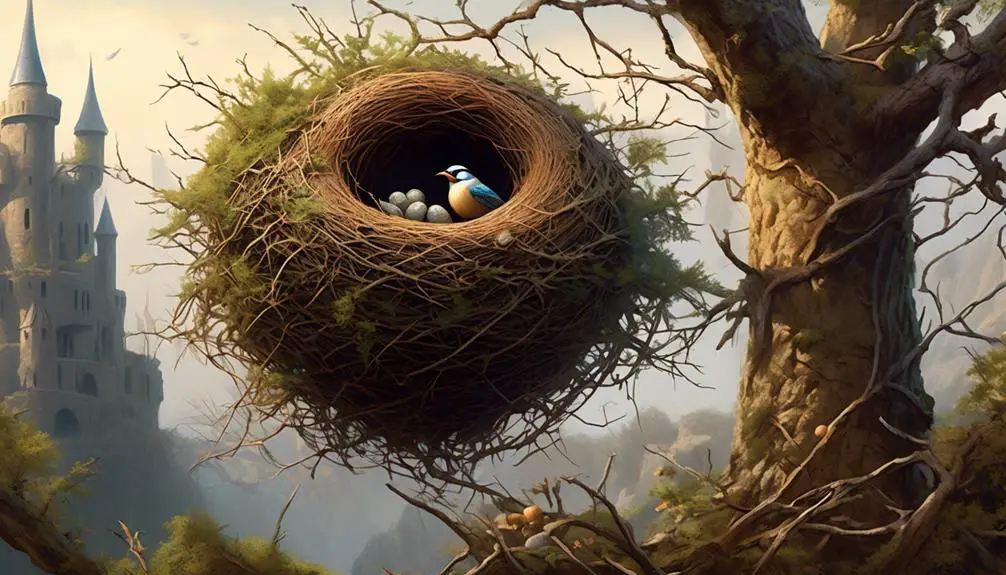
To protect bird eggs from predators like raccoons, opossums, badgers, and pigs, prevention strategies and nest monitoring are essential.
Fencing can be used to create a physical barrier that prevents access to nests, while pesticides can be applied to deter predators.
Regular monitoring of nests allows for early detection of predation attempts, enabling prompt intervention to safeguard the eggs.
Implementing these protective measures is crucial for the survival and conservation of bird populations.
Prevention Strategies
Implementing effective prevention strategies is crucial in protecting bird nests and eggs from being raided by animals that eat them. By employing a combination of physical barriers, deterrents, and habitat modifications, the risk of predation can be significantly reduced. Here is a table outlining some prevention strategies that have proven to be effective:
| Prevention Strategy | Description |
|---|---|
| Fencing | Install fences around nesting areas to prevent access by ground-dwelling predators such as raccoons, opossums, and badgers. Ensure the fence is buried underground to prevent digging. |
| Nest Box Design | Construct nest boxes with small entrance holes to prevent larger predators like snakes and raccoons from entering. Place predator guards on the entrance to deter climbing predators. |
| Scare Tactics | Use visual and auditory deterrents such as scarecrows, reflective tape, and predator calls to frighten away predators like crows and hawks. |
| Habitat Management | Create a habitat that is less attractive to predators by removing dense vegetation near nests and providing alternative food sources away from nesting areas. |
| Monitoring | Regularly check nests for signs of predation and take immediate action if necessary, such as relocating threatened nests or removing predators from the area. |
Nest Monitoring
Nest monitoring plays a crucial role in safeguarding bird nests and eggs from potential predators. By regularly observing and assessing nests, researchers and conservationists can detect signs of predator activity and take necessary precautions to protect the eggs.
Monitoring involves visiting nests at regular intervals to record the presence or absence of eggs, as well as any signs of disturbance or predation. This can be done through visual inspections or by using specialized cameras and sensors. By closely monitoring nests, researchers can identify patterns in predator behavior and make informed decisions about implementing protective measures, such as installing predator-proof fencing or using deterrents.
Additionally, monitoring allows for the collection of valuable data on nesting success, predator-prey relationships, and population dynamics, aiding in the conservation efforts of vulnerable bird species.
Impact on Poultry Farmers
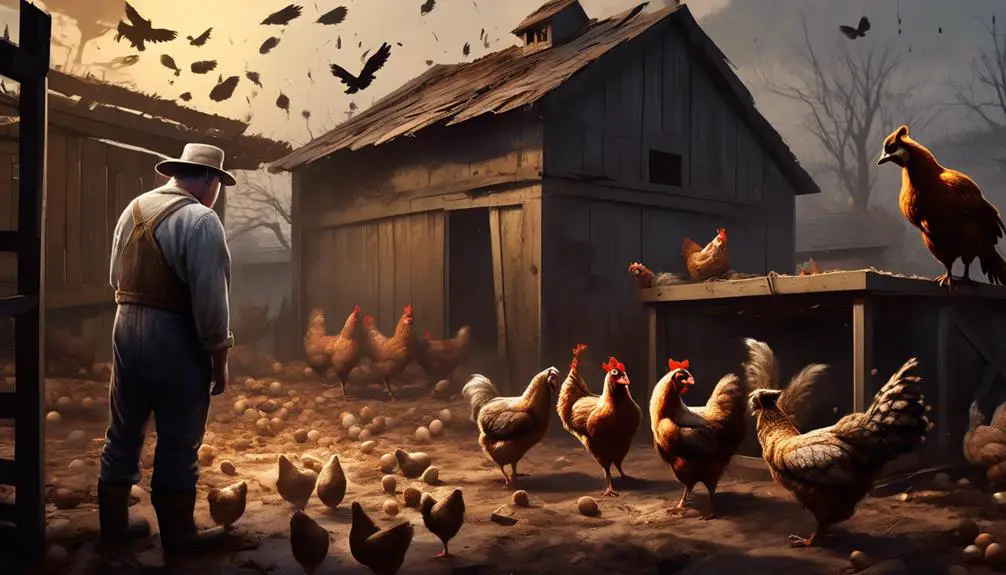
Poultry farmers experience significant challenges due to the impact of animals that eat bird eggs, such as raccoons, opossums, badgers, and pigs. These animals are opportunistic feeders and will raid nests to steal eggs. They have the physical abilities to access nests and break open eggs, causing damage to both the eggs and the nests. As a result, poultry farmers face economic losses as their egg production is affected. To provide a visual representation of the impact of these animals on poultry farmers, the following table illustrates the challenges faced:
| Challenges Faced by Poultry Farmers | ||
|---|---|---|
| Economic Losses | Damage to Nests | Reduced Egg Production |
The economic losses arise from the decrease in egg production, which directly affects the revenue generated by poultry farmers. Additionally, the damage to nests can lead to further expenses as farmers need to repair or replace them. With reduced egg production, farmers may struggle to meet the demand for eggs, which can negatively impact their business. Therefore, it is crucial for poultry farmers to implement protective measures such as fencing and the use of pesticides to prevent the attacks of these animals and mitigate the impact on their operations.
Ecosystem Balance

The presence of animals that eat bird eggs has a significant impact on poultry farmers, but it also plays a crucial role in maintaining the delicate balance of the ecosystem. These animals, such as raccoons, opossums, badgers, pigs, crows, hawks, blue jays, lizards, squirrels, groundhogs, snakes, and foxes, are opportunistic feeders that exploit the resources available to them.
While their predation on bird eggs can be detrimental to poultry farmers, it serves an important purpose in the ecosystem. By consuming bird eggs, these animals help control bird populations, preventing overpopulation and ensuring the survival of other species. In addition, they provide a source of food for themselves and their young, contributing to the energy flow within the ecosystem.
Furthermore, the presence of animals that eat bird eggs creates a dynamic and competitive environment. Birds have evolved various strategies to protect their eggs, such as building nests in inaccessible locations or camouflaging them. This constant interaction between predators and prey promotes the evolution of defensive mechanisms and enhances the overall biodiversity of the ecosystem.
It is important to note that the ecosystem is a complex web of interactions, and the removal of any species, even those considered pests by poultry farmers, can have unintended consequences. While efforts to protect bird eggs are necessary for agricultural purposes, it’s equally important to understand and appreciate the role these animals play in maintaining the balance of the ecosystem.

Erzsebet Frey (Eli Frey) is an ecologist and online entrepreneur with a Master of Science in Ecology from the University of Belgrade. Originally from Serbia, she has lived in Sri Lanka since 2017. Eli has worked internationally in countries like Oman, Brazil, Germany, and Sri Lanka. In 2018, she expanded into SEO and blogging, completing courses from UC Davis and Edinburgh. Eli has founded multiple websites focused on biology, ecology, environmental science, sustainable and simple living, and outdoor activities. She enjoys creating nature and simple living videos on YouTube and participates in speleology, diving, and hiking.

